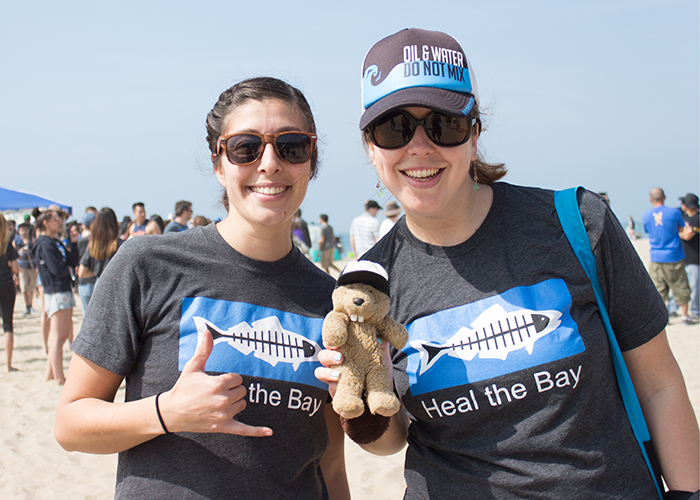
Will Rogers State Beach was swarming with people on this sunny California morning, not tourists but a hoard of Helpers picking up garbage for Heal the Bay’s monthly Nothing But Sand beach cleanup program! This place was bustling so much, I had to come back twice to catch Beach Programs Manager, Alys Arenas, for an interview.
“I think I’ve always had an interest in water,” she said during a lull in new arrivals to the event. “In 9th Grade, I went to visit my mom’s home town in Mexico, and they do not have running water. You have to buy bottled water there to get clean water. And I was like, there’s rivers here that people use to bathe in, wash in, whatever, and they’re completely soiled and polluted where they cannot be used.”
For her, after years of mapping manholes for the Orange County Sanitation District, Alys naturally wanted to move upstream by joining Heal the Bay, which has, for 32 years, focused on cleaning up Los Angeles County’s beaches, oceans, and waterways.
“In the 1930s, LA used to get flooded, so the storm drain system was built to prevent flooding. There are photos of people canoeing to get their mail. It got flooded.”
She then told me how these storm drains connect directly to the ocean from the streets. When a rain storm hits Los Angeles, just one inch of rain can send ten billion gallons of water (about twelve Rose Bowls) rushing into those storm drains and out into the ocean. With that water comes tons of garbage: plastics, oil, pesticides, and bacteria!
“We do, for human health, ask people to stay out of the ocean for about three to five days after a rain, because the pollutants are just that high. We also ask people to swim away from any kind of river going into the ocean or any drainage coming from inland by 100 yards, because the pollutants tend to be higher around that area.”
That’s where her job comes in. Alys coordinates these monthly beach cleanups as well as both the Adopt-a-Beach Program, which commits groups of 15 or more people to clean up a beach three times in a year, and the Suits on the Sand Program, which provides environmental stewardship programs for companies!
But most impressive is Heal the Bay’s involvement in Coastal Cleanup Day! This is the world’s largest volunteer event, a three-hour beach and river cleanup that takes place in 100 countries and 42 US states! Heal the Bay coordinates the 10,000 people that show up to clean in just Los Angeles County!
At that moment, Alys introduced me to Education & Outreach Manager and self-described “water rat,” Nancy Shrodes, who suddenly emerged from the crowd. She grew up in and around California’s coasts and had always been interested in joining Heal the Bay.
“I was very much a science girl from the get-go, and I majored in environmental science at school, focusing on marine biology. This was something I loved, I was interested in it, and I wanted to go ahead and protect it.”
In fact, Nancy pioneered Heal the Bay’s Know the Flow educational campaign. Not only teaching about coastal pollution, she wants more Angelenos to know that “80% of our water is imported from really far away, and all these different places have their own environmental concerns going on with them. Plus, [the aqueducts] all cross the San Andreas fault, which is kind of scary if we’re relying on that every day. If there were to be a Big One, are we going to be locked in without water?”
Nancy discussed their campaigns to locally source more of Los Angeles’ water instead of relying on the Los Angeles Aqueduct, which carries water 233 miles south from the Sierra Nevadas. Heal the Bay pushes hard for wastewater recycling and groundwater replenishment. For instance, rather than build an expensive desalination plant on the coast and wait for the trash-filled water to reach the ocean, the city could “capture, conserve, and reuse” ten billion gallons per rainstorm before it ever left the shore!
Apparently, there’s also a huge amount of groundwater underneath the San Fernando Basin, but it was contaminated by World War II era industry. Heal the Bay wants to reclaim and treat that water, then spread it over the Pacoima Spreading Grounds to recharge the entire basin with tons of usable water!
“You can’t fix a problem if people don’t know it exists,” said Nancy, “so you really have to let them know what’s happening—get them context—before you can really make these big sweeping changes that need to happen. Heal the Bay has always been at the forefront of that fight.”

To help the helpers at Heal the Bay, visit their website, healthebay.org. Check out their Nothing But Sand cleanup days every third Saturday of the month from 10:00 AM until 12:00 PM, and keep an eye out for the annual Coastal Cleanup on their Events page!
You can also how your local beach ranks on their Beach Report Card!